
Gar's Tips & Tools - Issue #169
Gar’s Tips, Tools, and Shop Tales is published by Cool Tools Lab. To receive the newsletter a week early, sign up here.
Hidden Tools Within Tools
Leah Bolden has done some eye-opening videos in the past about tools and common tool functions that many casual makers may not know about. Watching this recent video, I knew most of the hidden tools-within-tools she reveals. The ones that were new to me were the 90- and 45-degree angles built into handsaws and the tool inside of a retractable box cutter knife for snapping off the blades. Of course, this only applies to some models of saws and utility knives. My saws and knives do not include these features.
Project Farm’s Top Ten Products of 2023
It's that time of year again and Todd of Project Farm has posted his top ten products for the year based on his year of product testing. Tools on the list include 3-Ton Jack Stands, Bubba Kinetic Energy Rope, Drill Doctor Drill Bit Sharpener, and the YESWELDER MIG welder.
How to Properly Use a Crimping Tool
I don't know that much about crimp connectors, but I thought I at least had a solid command of the basics. Then I watched this video. In it, James Gatlin covers identifying different gauges of connectors, the difference in crimping insulated and non-insulated connectors, tips on using a crimping tool, how to properly execute a crimp, why you don't want to scrimp on your crimping tool, and lots more.
Maker Slang
Slang, jargon, and technical terms for the many realms of making things
[Value of Measurement] Strong (Example: “4-5/8 strong”) — Meaning the stated measurement (4-5/8”) plus a little extra, but that extra (4-11/16”) doesn’t matter at the resolution you care about measuring (e.g. framing a wall).
Baby fat - Used at JPL to describe extra storage space that you will soon grow out of. [Via Adam Savage]
Interference fit (also known as “press fit”) — A form of fastening between two parts where the parts are so tightly fitted together that the interference of their surfaces results in a secure join. Used in machining.
Peck drilling - A method involving periodically retracting the bit from the hole being drilled. The primary purposes of peck drilling are to improve chip removal, reduce heat buildup, and enhance lubrication of the cutting surface.
Shadow line - In industrial design, a feature where a narrow, recessed gap is created between two surfaces or panels. This gap is usually very precise and intentional, creating a visual effect that mimics a shadow. Shadow lines are often used to enhance the aesthetics of a product, giving it a more defined, sleek, and modern appearance.
Untying Knotty Knot Tangles
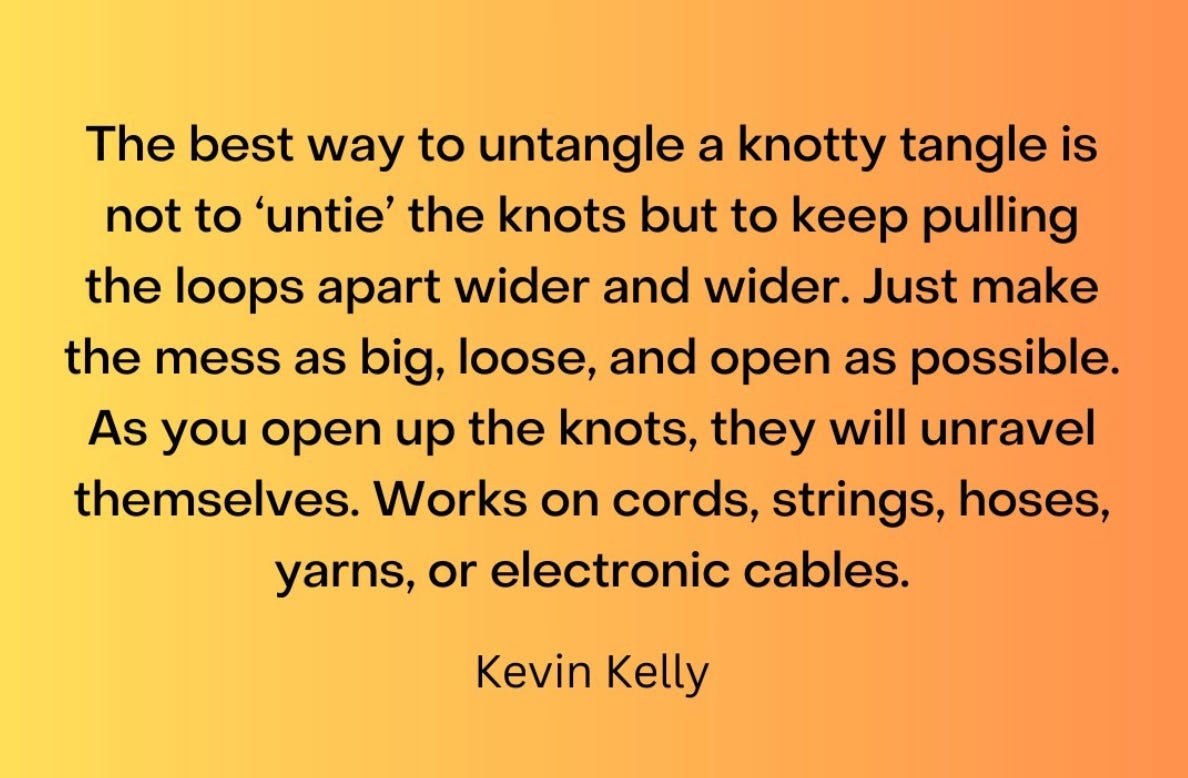
I’ve really been enjoying the Instagram excerpts from Kevin Kelly’s book, Excellent Advice for Living. I appreciate that they range so widely, from philosophical life lessons (“To manage yourself, use your head, to manage others, use your heart”) to the very pragmatic, as seen above.
Shop Talk
Readers offer feedback, tips, tales, and tool recommendations.
Michael Una writes:
In your most recent Tips & Tools, you mention that buying old tools is a great way to get started. I wholeheartedly agree, and I'll offer a tip here: If you ever see an estate sale, go into the garage or the basement and try to find the old guy's stash of tools and parts. Oftentimes, the estate sale company will grossly undervalue tools and let them go for $1-5 apiece. And, as you say, they are generally of high-quality, old American steel. I have acquired many clamps, saws, drill bits, chisels, copper wire, wrenches, pliers, and various hand tools from estate sales. Sometimes you might find an old table saw or drill press as well.
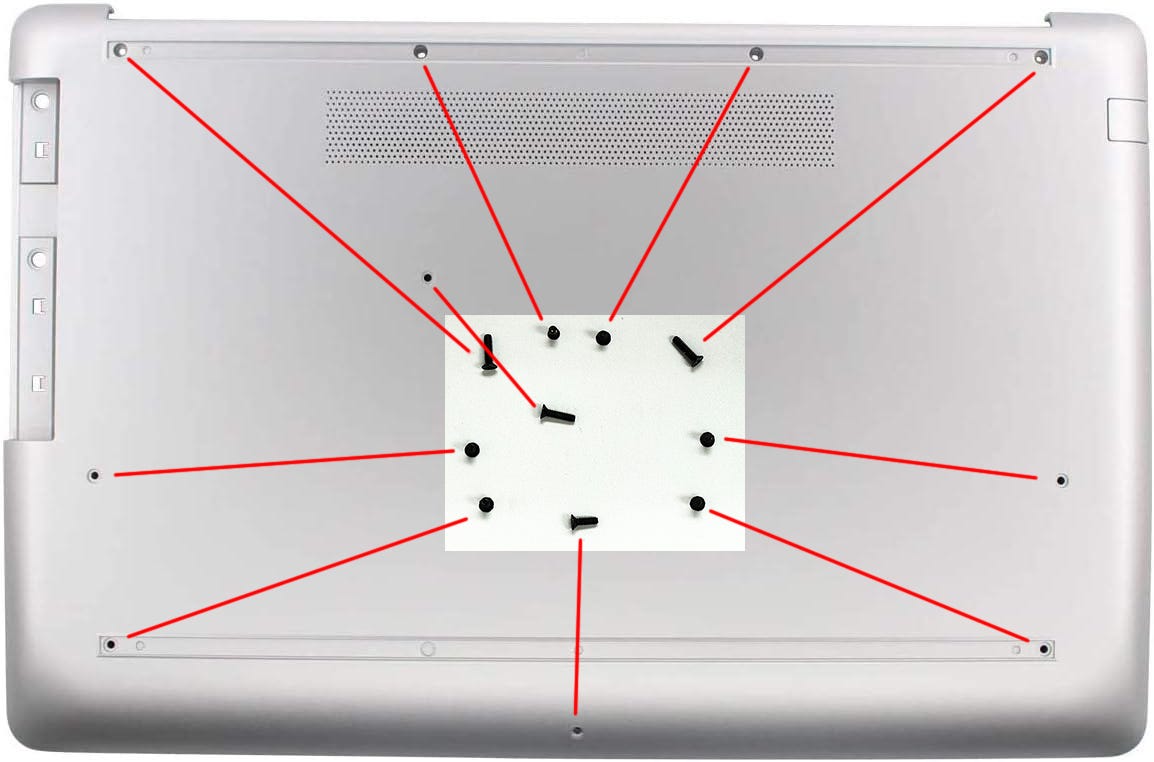
My old pal Andrew Sasaki sent in this tip:
If you remove different-length screws from a device, say the bottom cover of a laptop, it can be difficult to remember which screw goes into which hole. Placing the removed screws on a stable surface in the same relative positions they were removed from (see above pic) helps reduce the trial-and-error when you need to screw them back in.
Introducing The Whiteboard Deck!
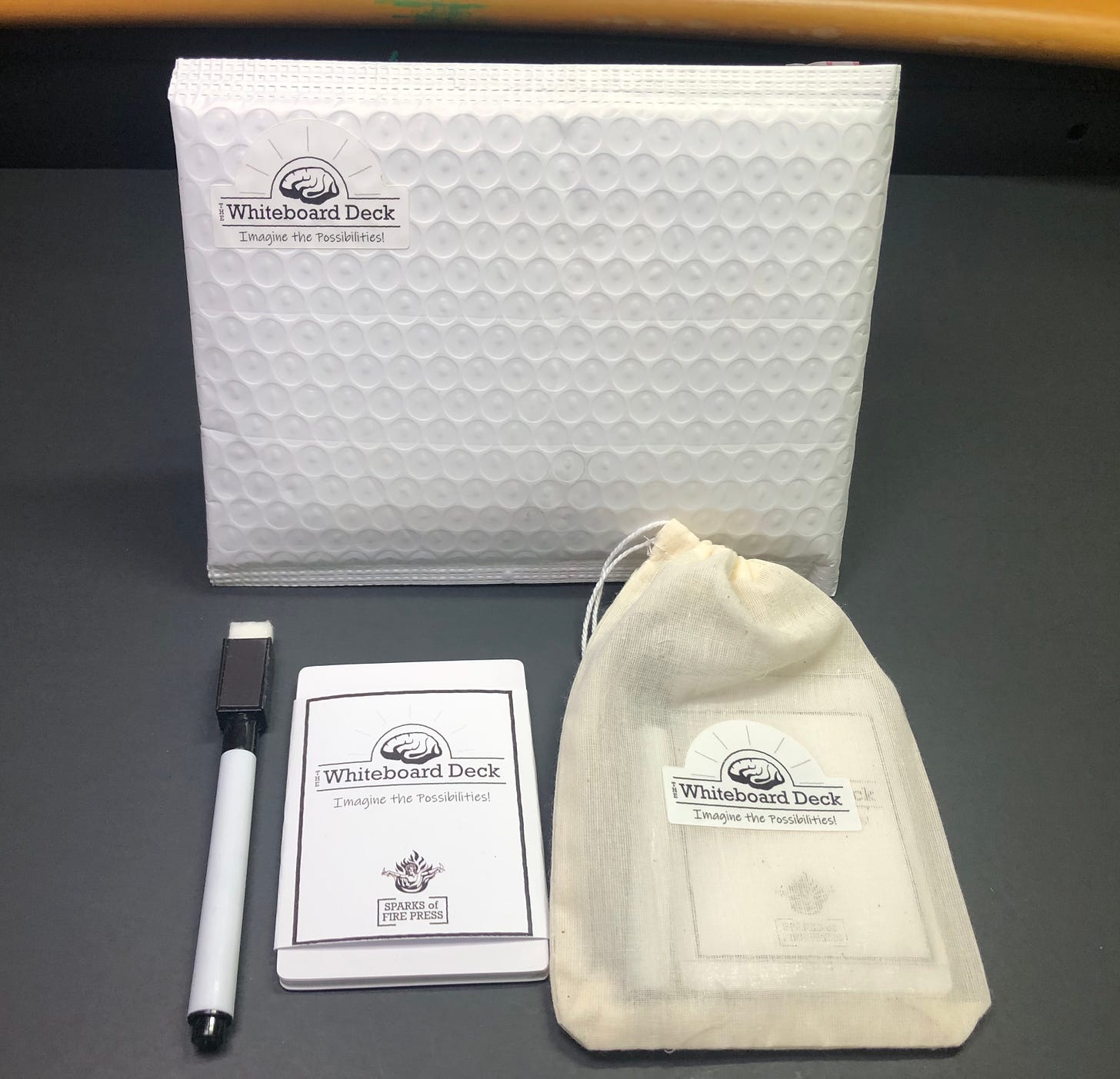
My latest product — 10 US Poker-sized (2.5" x 3.5") dry-erase cards wrapped in a paper band and stored in a muslin drawstring bag. The deck also comes with a fine-point dry-erase marker that has a sponge eraser and built-in magnet. The Whiteboard Deck is $10 with $5 shipping (foreign orders at the shipping rate to your country). Order up to five decks for the same $5 shipping.
The Whiteboard Deck can be used for everything from to-do lists, to notes around the shop, to idea brainstorming, to game design, to... Imagine the Possibilities! If interested, email me for payment arrangements.
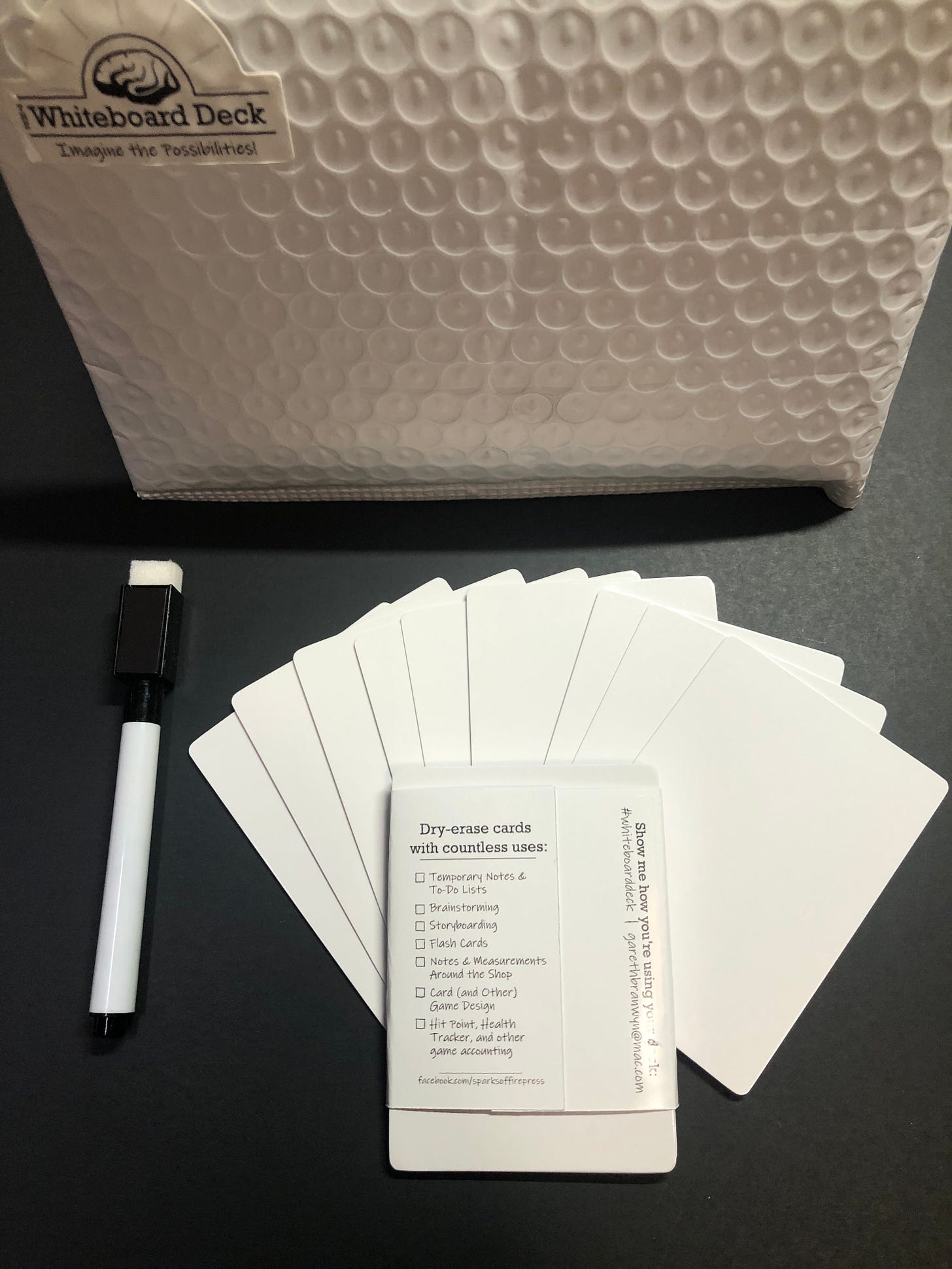

Slicers
Once a week we’ll send out a page from Cool Tools: A Catalog of Possibilities. The tools might be outdated or obsolete, and the links to them may or may not work. We present these vintage recommendations as is because the possibilities they inspire are new. Sign up here to get Tools for Possibilities a week early in your inbox.
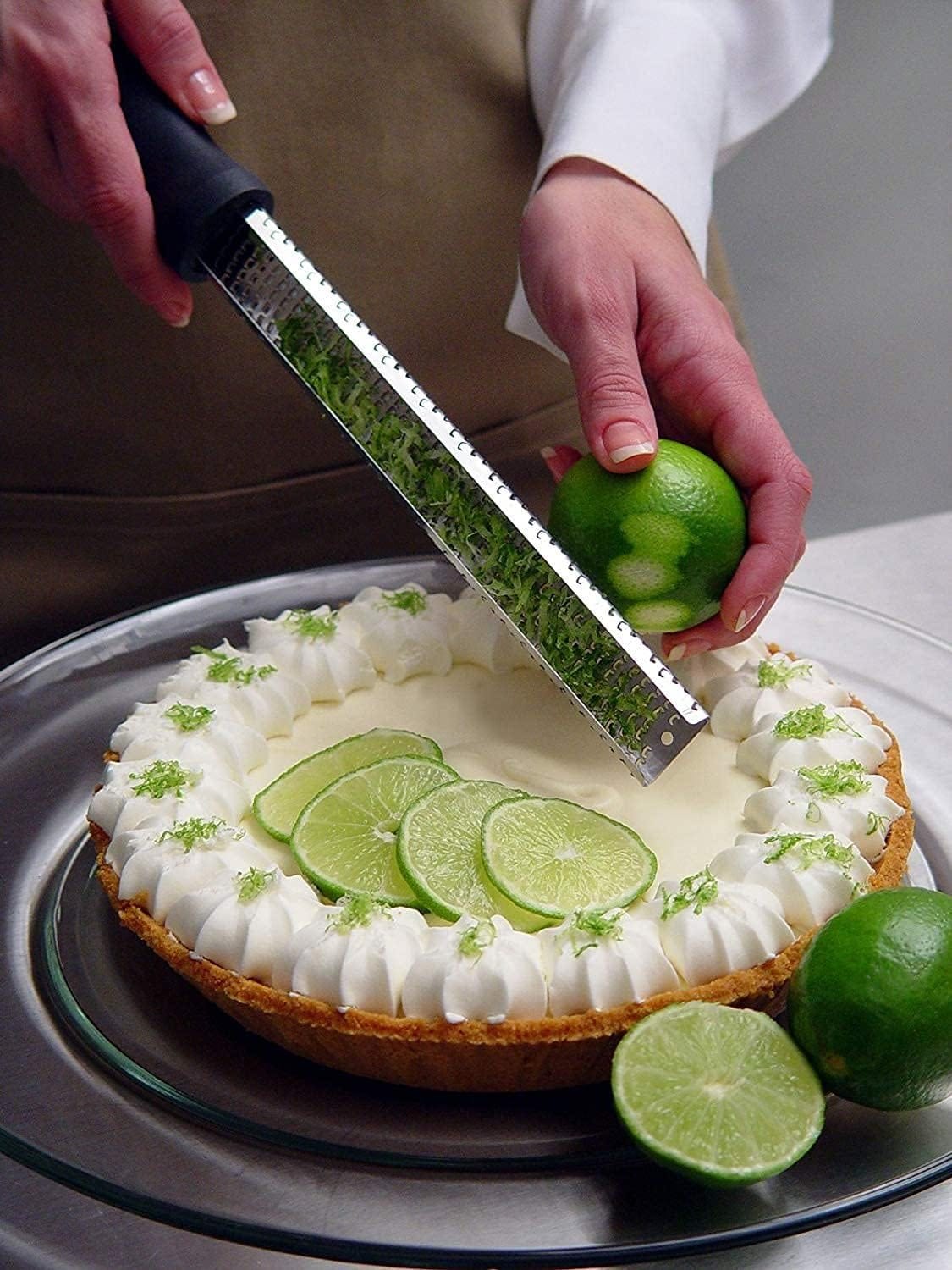
Precise sharp slicer for kitchen
Microplane began making micro-blades for woodworking use, but they’ve diverged into making fantastic kitchen tools. Their kitchen graters will turn a little block of Parmigiano-Reggiano into a huge cloud of billowy cheese wisps. Vegetables grate into little strips that almost melt in your mouth. My favorite use is with citrus zest. My lemon bars, lemon tarts and key lime pie have a much greater depth of flavor than ever before.
With most zesters, you end up with too much of the pithy white rind of the citrus fruit, but the Microplane takes off only the very thinnest layer of the outside of the fruit, the part which contains the intense and volatile citrus oils. Hands down, these are the best tools I’ve tried for fine-grating and zesting. — Jeff Zimmerman

Tears through tomatoes
I have dozens of tools and gadgets in my kitchen. Years working in the restaurant and catering world left me with an inventory of items that I bought for this job or that party. Some were quite expensive and most were probably only used once or twice (I’m looking at you, Mother of Pearl Caviar Spoon!).
But there’s one tool that cost me less than $2.00 at a restaurant supply store over 10-years ago that I still use on a fairly regular basis, at least during the summer. Anytime I need to core a tomato or hull a strawberry I reach for my Tomato Shark.
It’s a simple little metal spoon with sharp teeth that digs into your tomato or strawberry, removes the core or hull cleanly, and leaves you with just the fruit to work with. Unless you have super sharp knives and great paring knife skills you are probably used to coring a batch of tomatoes for sauce being a time-consuming and sometimes messy job; the Tomato Shark makes this job easy, tidy and quick.
This is one of those items where you should buy the actual Tomato Shark brand. I’ve found similar items just don’t hold up over time: the teeth get dull quicker, and you just don’t need to spend the extra money on a fancier version (unless you have problems with your hands and need a plastic handle for ergonomic reasons). — Caryl Shaw
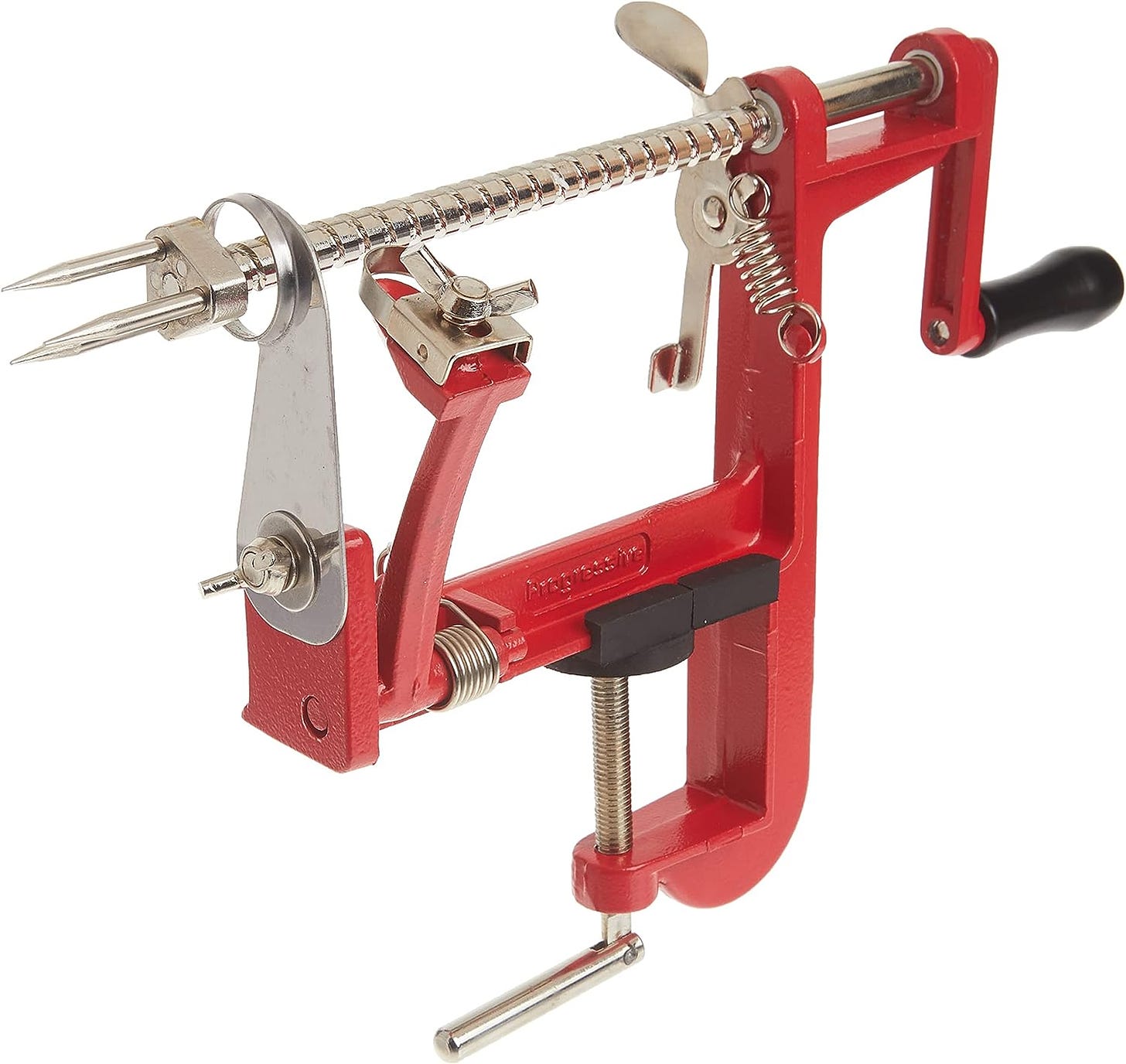
Quick apple peeler and corer
My wife’s grandmother seems to effortlessly make dozens of wonderful apple pies. And yet, she has poor hand strength due to advanced rheumatoid arthritis. Finally, we convinced her to pass along the secret behind her pie-making success: She uses one machine to peel/slice/core her apples.
Simply poke the three prongs into the base of an apple and turn the crank. Before you know it, a lovely spiral of apple skin will unfurl before you, leaving a perfectly cored and peeled apple that can be quickly cut into quarters and thrown into a pie.
As soon as you see the device in action, it’s obvious just how elegant the mechanism is. It’s safe for children to use, once the apple is situated on the prongs. Best of all, it makes prepping apples so simple you’ll wish you had one years ago. There’s a version that clamps to a kitchen bench, but I find the models with a vacuum base are the same price and are far easier to set up and use. — Steve Allen
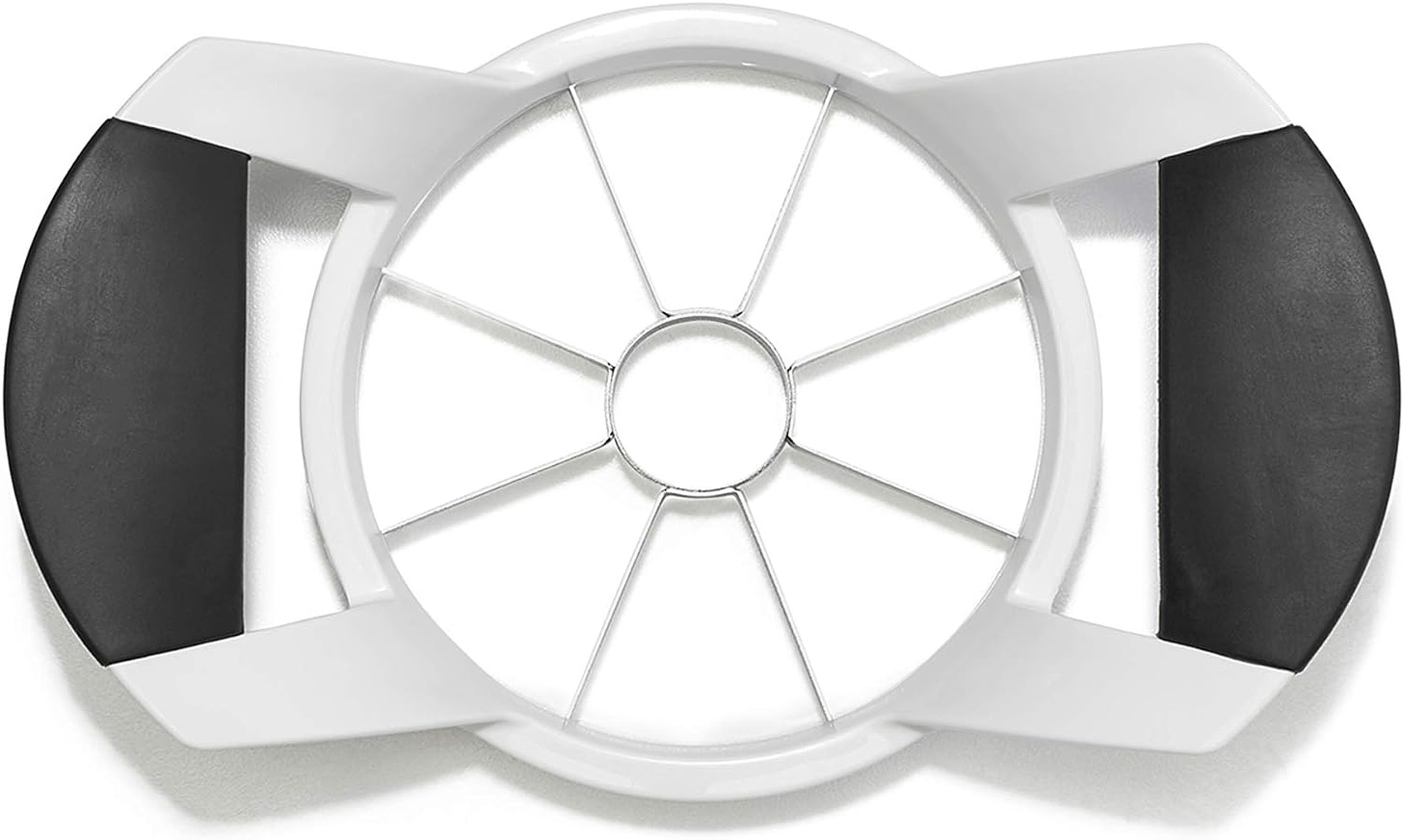
Healthy snacking in 30 seconds
I like apples but I’ve never been a fan of the form factor, which tends to be tough on the teeth and jaws. The OXO Apple Divider cores and chops in one fell swoop. Total prep time, including rinsing the apple beforehand: 30 seconds max, 20 if I’m in a hurry. Like other OXO products I’ve tried, the OXO Apple Divider is a well-designed, well-built version of a classic tool. The company’s included its trademark “good grips” and sharp blades.
I appreciate it every time I use, it because I’m a chocoholic with easy access during the day to cookies and hot chocolate. Bringing a plastic container filled with wholesome, fresh, organic apple chunks makes it easier for me to resist the lure of chocolate. Even if you don’t consume apples as frequently as I do, the OXO Apple Divider is one single-use tool that’s worth keeping around. — Jonathan Steigman
We we bought this and use it regularly on potatoes to make oven fries. Slice the potato, toss the pieces in olive oil and spices of your choice, and bake on a non-stick sheet for 20-30 minutes at 450F, turning once. I didn’t even know this device was actually for apples until I saw it on Cool Tools! — Julee Bode
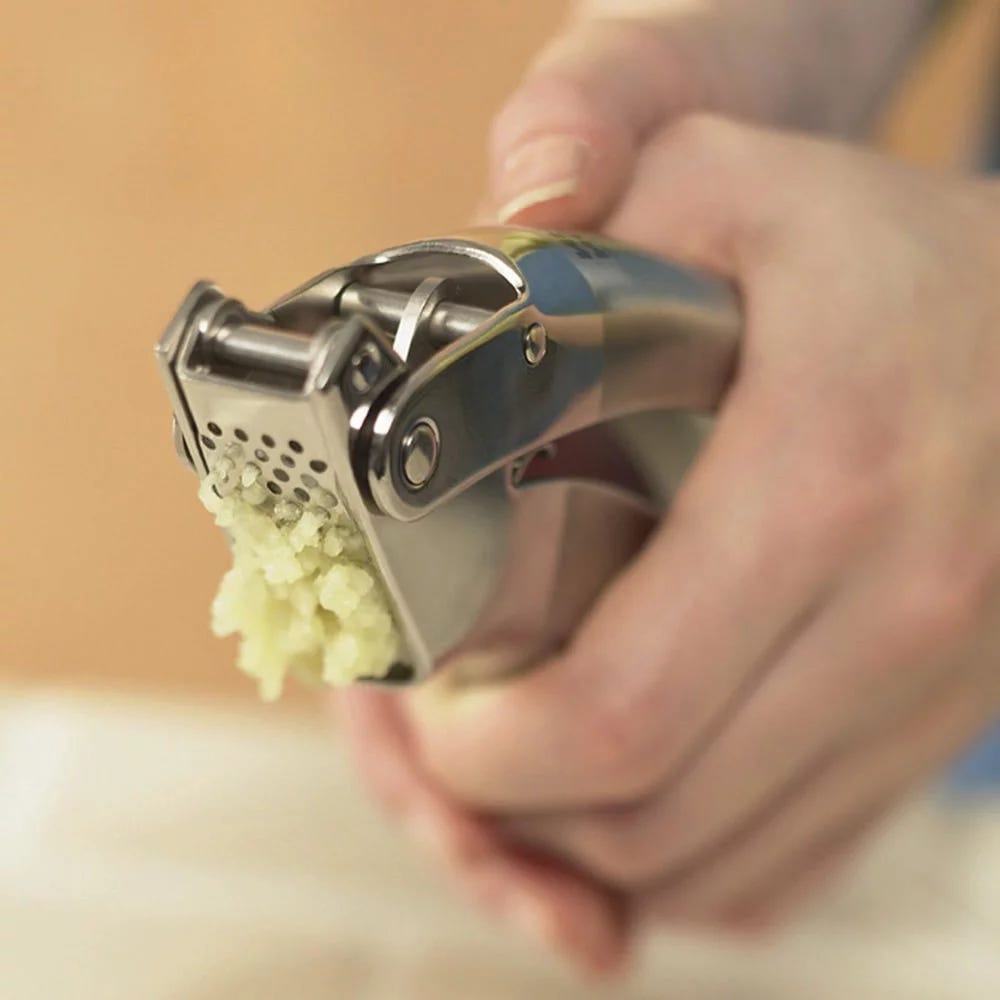
Best garlic and ginger press
Kuhn Rikon Epicurean Garlic Press
I’ve used this tool for about 10 years and it’s still going strong. It’s probably the best garlic press in the world. It’s constructed very robustly from stainless steel; it has an unusual lever-action which is far superior to the one-to-one action of most garlic presses; it opens up easily and is trivial to clean.
To see a demo, have a look at America’s Test Kitchen Equipment Review (below) where they come to the same conclusion.
But note that Kuhn Rikon have another garlic press called the Easy Squeeze, which is a lot cheaper. It has a slightly different action and plastic handles. It’s not nearly as good. — Stuart Wray
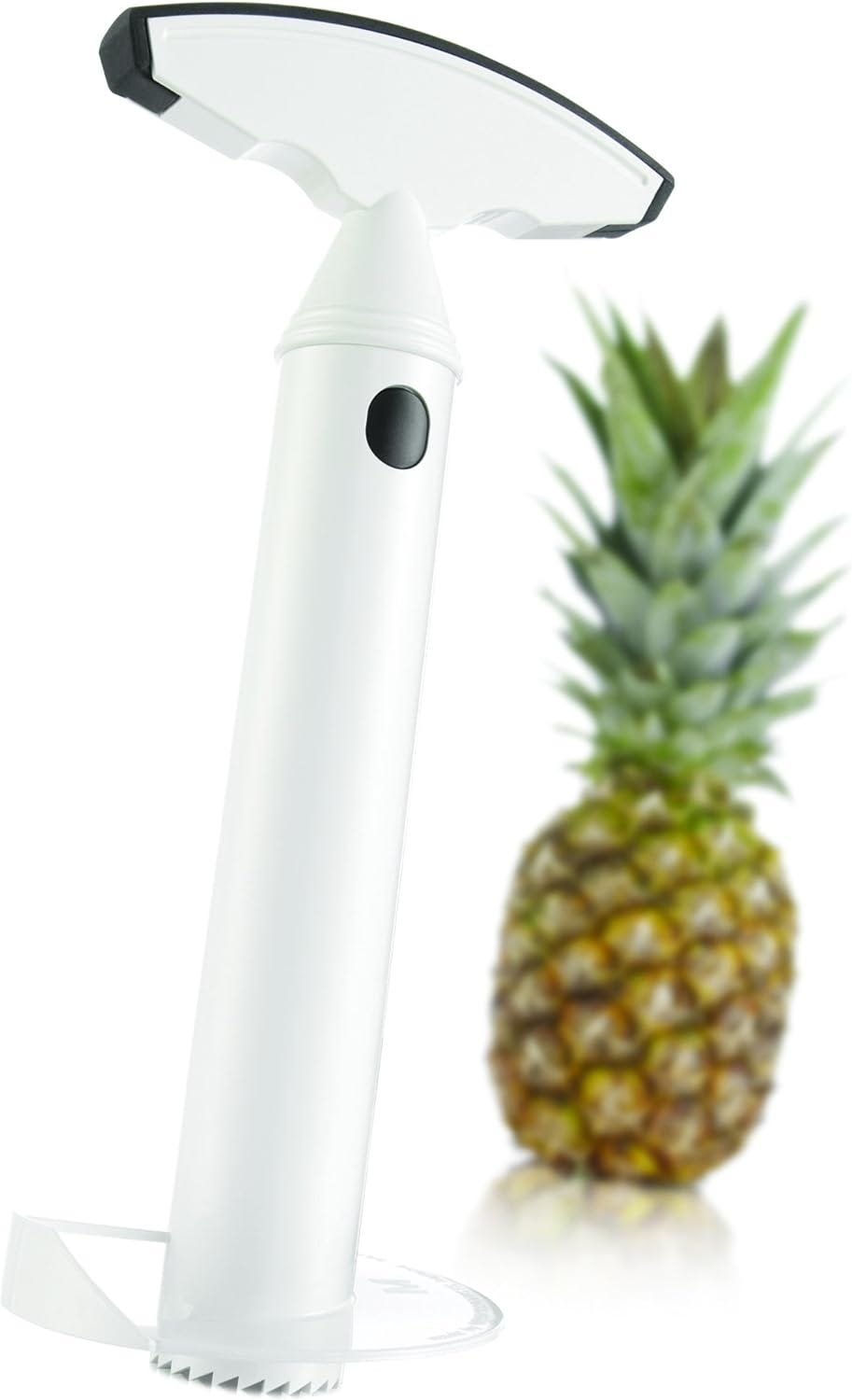
Bulk pineapple slicer
I’m not usually a big fan of single-use tools, but this is by far the only tool for this job. We had a party where I needed to core and slice three cases of pineapples, and what could have taken all day took but a few hours. No skill is needed. You just cut off the top of the pineapple and screw down the corer. Once you are at the bottom, pull out the meat and you’re done. The pineapple is evenly-sliced and you are left with a usable hull (for serving fruity drinks in, of course). I have seen these on sale for as little as $7. —Walter Susong III

Weekly Links, 12/01/2023
- Counter argument: the effects of social media on adverse well-being and mental health globally is minimal and inconsistent, says this peer-reviewed study. Global Well-Being and Mental Health in the Internet Age
- This very thorough, deep analysis shows how China is rapidly de-Arabizing local mosques, removing domes, arches and minarets, in its effort to "sino-ize" Islam. This visually innovative article from FT is worth your time. China Mosques
- How will generative AI affect employment? I think it will displace your job description rather than your job. As I argue in this @sxsw 2023 talk, think of them as interns, assistants or partners. The Universal Intern and Partner: How Generative AI is Changing How We Work

Home Schooling
Once a week we’ll send out a page from Cool Tools: A Catalog of Possibilities. The tools might be outdated or obsolete, and the links to them may or may not work. We present these vintage recommendations as is because the possibilities they inspire are new. Sign up here to get Tools for Possibilities a week early in your inbox.

How to get a real education
The Teenage Liberation Handbook
This book is radical. It tries to persuade teenagers to drop out of high school — in order to “get a real life and education” as its subtitle says. This is a dangerous thing to give to your child, because there is a significant correlation between amount of formal education and almost any outcome you care about, including longevity, divorce and poverty rates. Yet informal homeschoolers and unschoolers are outside of that measurement, and by most accounts are doing super. As a college dropout myself, I am sympathetic to alternatives to school.
The purpose of this book is to encourage the teen to make their education their own responsibility. They can remain at school, or as a homeschool take only some classes, or find apprenticeships, volunteer, or even skip directly to college. In short they are designing their own self-education, where ever it may happen. Along the way they develop a better idea of themselves and many more life skills then they would in formal school.
Today as the quality of the average public education declines these ideas are not as extreme as when the book was first written in 1991, but they still aren’t as accepted and common as they should be either.
This is a dense, packed book, overflowing with ideas, tips, anecdotes, cautions, and multiple views — all speaking to the teen and not to parents. It does not lay out a 1, 2, 3 plan. It is messy, challenging. The book itself is probably a pretty good filter for whether the idea of self-education is a match for a young person.
Our son petitioned us to be unschooled, and it turned out that one year when he was 12 was sufficient. It was one of the best years in our lives. Yet in his liberation from school, he discovered what learning “on his own” really meant. It’s challenging. He then choose to go to high school, but with a new attitude that he was in charge of how much and how well he learned. That new found responsibility for his own education made that one year of unschooling totally worthwhile.
There is a whole slew of homeschooling textbooks, advice, and well-crafted tutorials. All directed to parents. This is not one of those. This is a scribbled permission slip giving a teenage permission to consider alternatives for their own education. — KK
- This book is a wild card, a shot in the dark, a hopeful prayer.This book wants you to quit school and do what you love. Yes, I know, that's the weirdest thing you ever heard. Hoping to make this idea feel possible to you, I tell about teenagers who are already living happy lives without school, and I offer lots of ideas and strategies to help you get a real life and convince your adults to cooperate.
"Excuse me?" you interrupt, "Quit school? Right. And throw away my future and pump gas all my life and get Addicted to Drugs and be totally lost in today's world. Right."
If you said that, please feel free to march straight to the nearest schoolperson and receive a bushel of gold stars, extra credit points, and proud smiles. You've learned exactly what they taught you. After you get tired of sticking stars to your locker, do please come back and read further. - Suggest a trial run. you could start unschooling in the middle of August, so they have a couple weeks to see how you manage. Also, that would allow you to recover from the previous school year. You could agree that if they're not satisfied with your way of educating yourself, that you go to school. A drawback to this sort of timing is that you may feel cheated out of your normal summer vacation, and thus not as exhilarated as you would if you quit in, say, October. Also, the whole idea of being watched and evaluated runs contrary to the idea of pursuing interests because you want to. Still, you could probably psyche yourself into it and make it work.
- If you are completely confused as to how to start structuring your life, here's one way: Do "academics" for two hours each day--not necessarily lots of subjects, or the same ones every day. You are not going to dry up in you don't do 45 minutes every day of "social studies." Do some kind of "work" or project for four hours. In your leftover time, read, see friends, talk with mom and pop, make tabouli. Take Saturdays and Sundays off. Sound arbitrary? It is. I made it up, although it is based on a loose sort of "average" of the lives of a hundred unschoolers, mostly college-bound. Once you try this schedule for month, you will know how you want to change it.
- This book has said a lot of nasty things about school. Now it's going to say something nice. Schools have darkrooms, weight rooms, computers, microscopes, balance beams, libraries. They have choirs, bands, track teams, maybe even a Spanish class you want to take. Many enterprising homeschoolers have found ways to use the school resources they want without having to endure everything else.This chapter tells about a few of those ways schools can cooperate with homeschoolers, and gives examples of particular homeschoolers who have taken advantage of school resources. If the schools in your area have never tried anything like this, you can pass this information along to them, and assist them in setting up a program that helps both you and them. Yes, them.

Book to access books
This book really works! My daughter could read at age three, and has now really discovered the joy of reading at a young age. There are so many skills that kids can learn for themselves once they master reading. This is truly one of the fundamentals that is worth the effort to instill as early as possible. — James Hom
- The following are the four most important points about an effective sequence forteaching reading:1. The beginning exercises are simple and do not resemble later exercises (just as beginning piano exercises do not look much like advanced ones).2. The program provides teaching for every single skill that the child is expected to use when performing even the simplest reading exercises.3. The exercises change form slowly, and the changes are relatively small, so that the exercises are always relatively easy for the child.4. At every step, the program provides for very clear and unambiguous communication with the child.
- To decode the sentence Ruf unter glop splee, you simply say the words. This illustration points out that you may be able to decode without understanding what the sentence means. Traditional reading programs typically confuse the beginning reader about whether the teacher is trying to teach decoding or understanding. These programs typically begin with the teacher discussing the details of a picture. If the picture shows a girl named Jan, the teacher talks about Jan—what she is wearing, the color or her hair….It might seem that this communication is effective because it promotes interest and gives the children the motivation for both reading and understanding the written message.However, this communication may prompt the child to formulate a serious misconception about how to read. If the teacher always talks about thepicture before reading the word, and if the word is always predictable by referring to the picture, the child may reasonably assume that:- You read words by referring to a picture.- You must understand the word that is to be decoded before you can read it.
- English, clearly, is not a regularly spelled language. It is an amalgam of contributions from Latin, Greek, and French. But there are ways to simplifyit for the beginning reader.Distar solves the problem by introducing an altered orthography. This orthography does two things. It presents variations of some symbols sothat we can create a larger number of words that are spelled regularly (each symbol only having a single sound function). At the same time, the orthography permits us to spell words the way they are spelled in traditional orthography. Here is the Distar alphabet:

Free reading tutorials
Remember that greeting card company and famous-in-the-late-90s website Blue Mountain Arts? Well the extremely talented and philanthropic founders have started a learningto-read website, totally free, called Starfall.com. My daughters, ages 6 and 7, have literally gotten more educational value out of this than their schools. And now their schools are using it in their classes once a week! Super site, makes the most out of flash and audio on a broadband connection, and really a treasure for young kids (aimed at first graders and below) who want to get going with reading (at no cost).
— Jeff Blackburn

DIY school curriculum
When we homeschooled we were more into unschooling -- ditching a formal curriculum -- rather than replicating a school at home. Still, much learning benefits from structure, progression, and well, a curriculum. You’d like to have a good text book for geometry, or grammar. Or some order to present science concepts. There’s a huge industry selling extensive and expensive curricula to anxious new homeschooling parents. My advice is to get this book and assemble your own.
For each grade from pre-school to high school, the author and novelist Rebecca Rupp outlines reasonable skills and knowledge a pupil could master at that stage for different subjects. Rupp then recommends a refreshingly diverse set of resources for that subject and level, including the best textbooks that work at home, expansive readings around the subject, and even video series when available. You select from her highly curated selections and find the ones suited to your child(ren). In our experience her recommendations and options are excellent. They will likely be on the challenging side, rather than dumbed-down. And unlike many (if not most) homeschooling guides this one is not hampered by a dogmatic religious perspective.
Even if you are not homeschooling, kids learn at home, and this book would serve well to enlarge your child’s formal schooling. This guide supersedes the author’s previously recommended Complete Home Learning Source Book, which is a bit outdated and not as well organized. — KK
- Grade Six: Language Arts
Read a wide range of age-appropriate fiction and nonfiction materials. Kids should read a mix of classic and contemporary literature, novels and short stories,myths and legends, fables and folktales, poems, plays, essays, magazine articles, and newspapers. Literary experience should be enhanced with a range of supplementary resources, including biographies of writers, audio and video performances, and hands-on and cross-curricular activities. - At this grade level, kids should learn the techniques of writing an effective multi-paragraph essay: defining a main purpose or thesis, supporting the thesis with evidence and examples, distinguishing unsubstantiated opinion from proven fact, using relevant quotes from attributed sources, and providing a bibliography.They should be able to tailor their writings to a chosen audience or purpose: personal, academic, or business, for example.

Weekly Links, 11/24/2023
- Yes, we should have a library on the Moon. Introducing the Lunar Library II

Weekly Links, 11/17/2023
- I predicted that @WIRED's dumb anti-AI art policy would not last 2 years and I am happy to say it didn't last 6 months. They are using cool AI art in pieces like this one. Good move. @katiedrumm @glichfield What If the Robots Were Very Nice While They Took Over the World?
- According to Google AI researchers, artificial general intelligence (AGI) has already been achieved by LLMs. "ChatGPT and Bard are both trained to respond that they are not conscious." They make their case: Artificial General Intelligence Is Already Here

Theodore Gray, co-founder of Wolfram Research
Theodore Gray is a co-founder of Wolfram Research and creator of the Notebook user interface (since lovingly copied by Jupyter Notebooks). He is the author of several books and iPad apps including the NYTs best-seller The Elements, and writer/director of Disney Animated (BAFTA award winner and Apple's iPad App of the Year 2013). His latest book is TOOLS, which is all about his favorite tools.
TOOLS:
0:00 - Intro
1:58 - Drill bit set
5:56 - DeWalt cordless band saw
9:46 - Ma-Ant screwdriver holder
14:08 - Johansson Mikrokator compensator
23:45 - Handy Herman lift
28:00 - used electric forklift
29:24 - old milling machine
35:55 - Milwaukee impact wrench
41:58 - Tools: A visual Exploration of Implements and Devices in the Workshop
To sign up to be a guest on the show, please fill out this form.

Weekly Links, 11/10/2023
- Twitter (x) is about to release their generative AI called Grok. Their press release about it is a short note that gives a very good sense of the AI race. Announcing Grok

What's in my NOW? — Ana Bernardi
Sign up here to get What’s in my NOW? a week early in your inbox.
I am a 34-year-old software engineer, living with an angry bird that sings “Happy Birthday” every day and wishing for sunny days to go out and ride my bike.

PHYSICAL
- Blanket: I don't know why I feel the need to use a blanket everywhere inside my house. I have a different blanket for each chair, couch, or bed in my home, even during the summer. I'm currently typing this while using a blanket on my home office chair.
- When I'm doing an activity that requires focus, I really like to use my headphones. They're Bluetooth ones, and their audio is great.
- I'm addicted to data and statistics; I don't miss an opportunity to generate or read them (especially if there are graphs). That said, I always wear my smartwatch when I'm working out. It tells me if I'm doing well or if I've broken my records. It's really exciting (at least for me).
DIGITAL
- I cannot live without my Spotify account. When I need to focus on my work I just put a great song and the magic happens.https://open.spotify.com/embed/playlist/6HsxRCBQAVTR1LMd4XpYIl
- I really like to relax with a gameplay YouTube video playing in the background. The streamer I consider the best for this is the one called "T90". He streams Age of Empires 2 games, and even if you don't pay much attention to the video, it can be relaxing and satisfying.
INVISIBLE
- I'm always reevaluating and reviewing my ideas. Maybe there are times when I am wrong and could potentially be causing harm or doing something bad to someone. Besides, there's no harm to myself in double-checking the things I do.
What’s in your NOW?
We want to know what’s in your now — a list of 6 things that are significant to you now — 3 physical, 2 digital and 1 invisible.
If you’re interested in contributing an issue, use this form to submit: https://forms.gle/Pf9BMuombeg1gCid9
If we run your submission in our newsletter and blog, we’ll paypal you $25.

Podcast Guests Wanted

This year (2023), our humble Cool Tools blog enters its third decade. We’ve posted something new everyday for 20 years! That is only possible because of the engaged and knowledgeable readers of this site. You have kept this place going with your enthusiasm and support for reader-generated positive reviews of cool stuff. Thank you!
Now that we are a young-adult, we’d like to open an invitation to our readers to join me, Kevin Kelly, on our Cool Tools Show and Tell video podcast. If you feel you’d make a good guest on the podcast and have four uncommon tools you’d love to share, then please sign up here. You must be comfortable talking on video, and have some of your tools at hand to show. (We record audio and video on Zoom.) Use this form to supply your name, your four favorite uncommon tools, and their links to a source.
Applications are not automatically guaranteed a slot on the podcast. We’ll consider each application based on whether the tools have been reviewed before, and how appropriate they are to the site, and how many slots for readers remain.
We welcome readers from any part of our diverse world, although any tool recommended must be currently easily available online in the US. I know that our readers are often just as interesting and informed as most of our past guests. Also, if you are a long-time reader you will realize our definition of tool is very broad — any thing handy or useful. So surprise us! — KK

Weekly Links, 10/27/2023
- Yes, you can teach an AI (LLM) to forget specific things, but this requires the AI to intensely learn the thing first in order to unlearn it by inventing substitutions. Important new paper describes this interesting research: Who’s Harry Potter? Approximate Unlearning in LLMs

Weekly Links, 10/20/2023
- Two points for @VitalikButerin for 1) trying an audacious experiment in living and 2) writing up and sharing the results. What happens when 200 rationalists live together for 2 months? Why I Built Zuzalu
- The newest upgraded version of the turbo encabulator is out, and it is essential to dampen those side wiggles on your magneto. It is especially good with hyper security. SANS ICS HyperEncabulator

David Buxton, Tech Founder
David Buxton is a tech founder based in London, UK. He loves making stuff, especially with software. He's also a qualified pilot and a pretty good cook.
TOOLS:
0:45 - Workflowy
12:54 - Tern GSD e-bicycle
19:47 - Langchain (LLM dev framework)
27:29 - Leuchtturm Line a Day journal
35:43 - Harriet AI HR assistant
To sign up to be a guest on the show, please fill out this form.

Weekly Links, 10/13/2023
- I'll read anything by Brian Eno. Here is his latest thinking on how he approaches his art. It's in the FT, called "Why I Sculpt Sound." Brian Eno: why I sculpt sound
- A flavorful report in the NYT on prediction markets today. TLDR: still hobbled by weird gambling laws that prohibit betting on news events (but okay on sports, etc.) The Wager That Betting Can Change the World

Weekly Links, 10/06/2023
- It's great that "long-term art" is now a thing. This new one in Germany is genius in its choice to use a non-valuable material like concrete, so it will never be stolen over time. Until 3183 A.D., This Public Sculpture Is a Work in Progress

The Sphere, a new platform
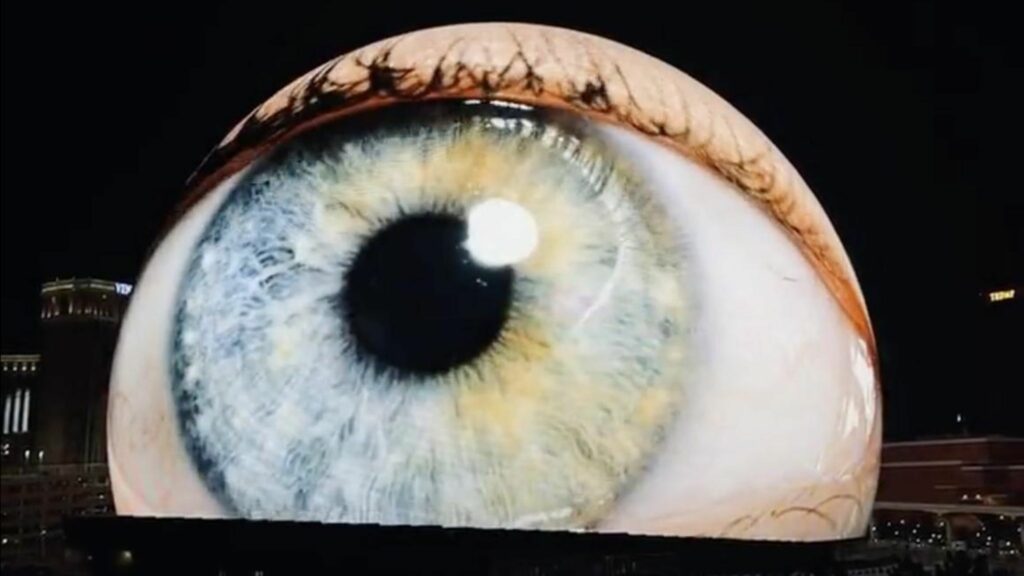
You can see the Sphere from the air as you fly into Las Vegas. It is a monumental globe wrapped in pixels — a spherical screen. One moment the building is a gigantic eyeball blinking, the next it is morphed into a slowly rotating basket ball thirty stories high, the next it is a crystalline Moon that feels as real as a planet. Part of the Sphere's magic is its scale; it can be seen miles away. Its wizardly transformation from one whimsical appearance to another serves as a billboard. What it is advertising is the Sphere itself.
The inside of the giant globe is lined with an even finer video screen coated with 25 million tiny pixels. It is the largest hi-res screen in the world. When you stand or sit inside the Sphere’s cavernous cavity, your entire gaze is filled. As you look forward, or up, or to the side, you see images that surround you as clear as day. And since this screen wraps beyond the corners of your peripheral vision, you feel immersed in its fantasy. When the Sphere renders a vista of a desert mountain sunset, you feel as if you are right there in the dust at dusk. In short, the Sphere allows you to experience most of the magic of virtual reality without any goggles or glasses. That naked virtuality is exhilarating. And you experience it communally, with 38,000 other people at the same time. This social dimension makes it both more intimate and more like a spectacle.
Costing $2 billion to build, the Sphere is designed to be a next level venue for rock concerts, cinematic blockbusters way beyond IMAX, theatrical extravaganzas, and mass VR experiences. Besides its mind-blowing graphics, it can also create mind-blowing audio. Using new audio techniques (1,800 speakers) never before unleashed at this scale, every seat in the audience of the Sphere gets a targeted beam of sound tweaked for that seat. This beam of sound is so precise that someone sitting a few seats away could hear something entirely different (say a different language) and there would be no bleeding of sound between them. This precision location accuracy means that the resolution of the sound is as high as the graphics. Every person in the audience receives perfect sound, no matter where they are. It’s like hearing high fidelity stereo audio without earphones. Because you are sitting there without goggles or earphones, yet floating in realism, alongside thousands of others who are also present without visible technology, it feels magical.
Superficially the Sphere is an amped up light show. For decades big rock bands have filled arenas backed with huge displays, and state-of-the-art pyrotechnics. But these huge displays still only fill a small part of your forward vision. The Sphere in contrast, fills the world as far as you can see in any direction. Its architecture is similar to a planetarium; a half dome sits over a raked incline of seats. But the show in a planetarium is projected onto a screen; its images are pale and coarse, while the Sphere’s LEDs emit incredibly brilliant, crisp and luminescent visuals, and in such high resolution that the images appear to resolve in infinity. In addition, the patented sound beams, instead of a wall of sound, add up with the visuals to create an overwhelming impression of realism not found in any other medium.

The Sphere is also more than just an expanded IMAX. The dome screen is so bright that it lights up the entire audience plus anyone on the stage at its center. This stage lends a theatrical element to the venue's strong cinematic nature. When musicians, actors, or presenters gather on the stage, they reveal the Sphere’s true enormous scale, and this also adds to its verisimilitude. The surface of the LED screen is so distant (150 feet) that your eyes are actually focused on far away things, rather than pretending to focus far while actually focused on a nearby screen. Unconsciously, this usual focusing conflict causes stress, while in the Sphere your eye/brain relax and you intuit the distance and scale, which makes the rendered world feel big. The high resolution means the movement of people, vehicles, nature in the distance, which are normally too small to be discerned in detail in most media, are now rendered in the same way you’d see them in real life. I call this singular feature a “distant intimacy,” and this furthers the uncanny realistic atmosphere.
The Sphere’s owners plan to replicate the Sphere many times, like suburban IMAX movie theaters, or stadium arenas. I understand that inclination because I think the Sphere represents a new platform, a new media. It is part cinema, part theater, part VR, part concert stadium, and part Times Square. So far, all this tech has been used to amplify the WOW. It’s really good for playing around with scale, for generating trippy experiences, and grand hallucinations with intense realism. The legendary band U2 launched the venue’s opening evening with a far-out show of psychedelic visions and rock and roll. Clips from the concert spread virally as the show unfolded. Quickly following them a week later, cinematographer Darren Aronofsky will debut the Sphere’s cinematic talents with “Postcards from Earth”. His team developed special cameras to record life semi-spherically in order to maximize the field of vision seen on the inner dome. The shows are spectacular, if not outright spectacles. It remains to be seen whether the Sphere can make people cry, and walk out moved in their souls.
This is just the beginning. The very first movies emphasized the wow factor — locomotives rushing right at the audience. To date one band and one movie director have had a chance to create content for the Sphere. It will take a while to figure out exactly what excels on this new platform. The capabilities of its screens and audio, driven by immense computation, suggest that the 3D engines powering todays’ video games and VR might be able to create worlds that could be explored in common by an audience in ways that neither solo games, VR, or movies can do. I could imagine new varieties of e-sports taking off in the Sphere.
The Sphere does not work scaled down — that is just VR. Because it needs to be physically big, you will not have one in your bedroom. So you’ll have to travel to somewhere to visit one. It is easy to believe that local movie theaters might be rebuilt as Spheres (at least on the inside) to attract all the people who no longer go to theaters (like me) because their 80-inch screen at home is just as good. The Sphere offers an experience that will be hard to duplicate outside it. A crucial large factor in that experience is its communal nature. The visceral power of tens of thousands of people sharing the same emotions will be worth the price of entry. The more we sit at our desks along all day, the more valuable community entertainment will become. Concert and sports stadiums offer communal emotion, but in a very limited emotional range. The Sphere platform has the opportunity to create content that offers communal emotions that soar in many other directions.
The Sphere is worth going out of your way to experience. In the feverish hysteria during the Sphere’s opening concert someone tweeted, “Late stage empires don’t build things this extraordinary.” I would not go that far, but without a doubt it is a massive technological achievement. It is too early to tell if it will be a marvel like the singular Pantheon, or one of many like Roman colosseums.

New US Train Route/Laptop Luggers/Better Short-term Apartment Rentals
A weekly newsletter with four quick bites, edited by Tim Leffel, author of A Better Life for Half the Price and The World’s Cheapest Destinations. See past editions here, where your like-minded friends can subscribe and join you.
New Train Route in North America
It’s been a long time since I’ve seen a headline like that and it actually delivered: usually it means there are plans that might happen a decade from now. But on Friday, the new Brightline train from Orlando Airport to Miami will finally be running for real. It stops at West Palm Beach and Boca Raton too, or you could switch to local service for a stop and get to the Ft. Lauderdale or Miami airports. The next phase, which is still “someday,” will connect Orlando and Tampa. Watch future issues about new lines coming soon in Mexico too, ones the president already rode on for photo ops.
“Laptop Luggers” Profile
A Deloitte report based on a survey conducted in March and April predicted a huge summer for international air travel (they were right) but had some interesting insights on "laptop luggers" who planned to work while they were away. Those bringing a laptop were wealthier (39% making $100K+), more confident about their finances, and planned to take an average of 3.8 trips over the summer. They're not stereotypical loners: "One in four will travel with 3–5 people, while over half of disconnectors are traveling with one other adult." (via Kevin Kelly)
Home Swaps for Working Travelers
Have you ever rented an Airbnb place that promised fast Wi-Fi, only to find you couldn’t get any work done because it was down or super slow? And that you had to work from a bed or sofa? Noad Exchange (an occasional Nomadico advertiser) is trying to change all that with a home exchange program just for working travelers. Every listing must have internet speeds of 20mbps or more and have a place to get work done. Once you join and list your own place, you only pay one credit per night plus the cleaning fee, making it far cheaper than renting through Airbnb or Booking as well. Use ALCENTRO as the promo code to get 3 additional credits when you sign up and if you feel like taking a flyer on an early-stage investment, they’ve got a funding round going too, with low minimums.
Digital Nomad Visa Realities
The hype about digital nomad visas seems to be dying down in the mainstream press as it becomes clear that some of these big announcements aren’t going anywhere anytime soon. Some of the plans that are real have hidden tax implications or onerous paperwork requirements that don’t suit the self-employed. We’ve linked to a few round-up reports in the past, but this seems to be the best one for digital nomad visas you can apply for now and they’re laying out all the cons, not just the pros. Don’t forget that in these other countries that allow long-stay tourist visas, you may not need residency anyway if not moving there permanently.

Maker’s Muse
Gareth’s Tips, Tools, and Shop Tales is published by Cool Tools Lab. To receive the newsletter a week early, sign up here.
– Send me a tip or tool recommendation.
–Tell me a shop tale.
–Buy my books (Tips and Tales from the Workshop Vol. 1, Vol. 2).
–Advertise your product, service, newsletter, app, book, tool, or anything you’d like to share with GT&T readers.
Maker’s Muse

Coolest propane tank ever!
How PID Controllers Work
In your travels in the world of electronics, however casual, you have most likely encountered the term "PID controller." In this Digi-Key video, Shawn offers a crystal clear introduction to what PID (proportional, integral, derivative) is and the science of Control Theory behind it.
In the video, we use an example of a cruise control system in a car. We want to design a mechanism that can maintain a constant speed by controlling the position of the accelerator (gas pedal). PID controllers are a perfect fit for such a system. In fact, most modern cars use PID controllers for cruise control.
A simple, naive approach to designing such a controller is to adjust the process’s input signal based on the set point alone with no feedback. This is known as an “open-loop control system.” This may work in some cases, but most of the time, the output is dependent on other factors (such as road conditions and hill climbs for our cruise control system). As a result, we need to incorporate feedback into our controller.
A “closed-loop control system” measures the actual output of the process and compares it to the set point. The error is the difference between these two values, and it’s used as the input to the controller. The controller looks at that error and makes adjustments as needed to the process’s input.
Scissor Sharpening Basics
Confession time: I absolutely suck at tool maintenance. I avoid it like the plague. Every year, I tell myself that I want to get better, and every year, little changes. At least this year I told myself I would be better about cleaning the gardening/yard tools and have done OK with that. Part of this maintenance aversion means that I never sharpen anything. But, after watching this video, I decided to at least sharpen our scissors collection. In the video, James uses a cheap flat file and a diamond sharpening/whetstone to get the job done. Like James in the video, I have several pairs of lovely vintage scissors that need this kind of TLC. After the scissor sharpening, it should be on to the knives. Our kitchen knives are laughably dull. Do you share a similar aversion to sharpening and other forms of maintenance?
Looking at Hobby Brushes under a Microscope
In this Goobertown Hobbies video, Brent delves into some hobby science with his new digital microscope. Using it, he peers into a bunch of synthetic and natural bristle paint brushes, from the very cheap to the expensive, from the new to the very well used. The results are fascinating. Under the microscope, you can really see why natural bristle brushes are superior to synthetics, how the tension in their fibers helps in keeping the integrated, pointy shape of the brush. One of my favorite parts of the video was seeing his dirty old brushes under the scope before and after a thorough cleaning.
TOYS! Magnetic Project Mat

Via a Cool Tools “Tools of Possibility” newsletter, I was reminded of this wonderfully useful iFixIt magnetic parts mat for assembly/disassembly of electronics. Not only is it magnetized to keep all of your parts in place, it’s also a whiteboard so you can label everything and even take notes. You can also get one for half the price on Amazon.
Revisiting “The Kenny Rogers Rule”
In having done this newsletter for the past 5 years or so, I am frequently asked what are my top-most tips? What are the ones that stick, that “changed my life” (or at least my workflow). I was reminded a few nights ago of one tip that would be at the top of such a list: The Kenny Rogers Rule (as in “You've got to know when to hold 'em, Know when to fold 'em, Know when to walk away, Know when to run”). This is a name I came up with years ago for knowing when to take a break from a project that has turned to little but frustration. The other night, I was trying to put together a bed frame that was not cooperating. It was all the things we know all too well about modern flat-pack furniture: warpage, improperly-drilled holes, cheap hardware, confusing instructions. By the time I was down to the last two nuts and bolts, I was struggling, sweating profusely, and rung tight with curses and frustration. I decided to put the tools down and come back tomorrow. In the morning, rested and with a new dedication to getting this damn thing done, it took about ten minutes to finish (with nary a bead of sweat or profane utterance). A perennial lesson from Kenny to us all.
Shop Talk
It’s always interesting to see which posts are going to get the most response. It turns out (OK, no surprise, really) that everyone loves pasta and has something to say about it. I got the biggest response ever to the item I posted in the last issue about cooking spaghetti right in the sauce instead of in water.
Just a few examples:
Steven Roberts: Yes on the pasta in sauce... been doing this for years, both with fresh pasta from my extruder and dried stuff. Originally motivated by being on the sailboat and wanting to minimize fuel, steam generation, and water waste... but I came to like the effect of cooking something in flavor so it's not just a neutral substrate. Coupled with making pasta that contains herbs, it's another variable to play with that has a side benefit of resource management... but so much with creamier sauces unless you do the wine part first then add heavy cream near the end. I never turned it into a formula, but when I do that I just make the sauce more watery than usual, then adapt on the fly if I underestimated. (For some things, that differentiation between substrate and sauce has greater expressive value, and the equation is more about fuel and water resources. It's more of an addition to the toolkit than a standard protocol.)
Daniel Kim: It turns out that you can soak pasta in cold water to make it pliable. This can be stored in a bag in the refrigerator, and then put in to the sauce when you heat it up. (When I've tried cooking pasta in sauce, and have leftovers, the pasta gets too soft for me)
Amit Agrawal: Also, this trick thickens the pasta sauce from the starch in the pasta.
George Mokray: I save pasta water for other uses later.
P. Korm: Cooking the pasta in the sauce is a trick that Ralphy shows Jackie Jr. in season 3 of The Sopranos. Though, of course, it's not tomato sauce, it's "the gravy'.”
Matt Middleton: If you have a standalone pressure cooker (e.g. Instant Pot), you can do the same thing; you need about 16 oz of sauce, 16 oz of liquid (water, broth, wine, etc.), and 16 oz of pasta. Meatballs are optional, but recommended IMO; if using, add them first. Break long noodles and spread out so they don't clump too much, then dump sauce and liquid over everything. Set it for high pressure, and cooking time is about half whatever the box says; the linguine I usually use says 9 minutes, so I round down to 4. Quick release the pressure, and if yours has a Keep Warm setting, turn it off. When safe, open and use tongs to stir up the noodles. They might seem a little underdone, but that'll fix itself up quickly enough. My kiddos prefer the frozen box meatballs, so I use those, but you can class it up with your own fresh ones, saute onions & garlic before adding sauce, or any other technique you like to build up some extra flavor.
And someone even upped the ante by sending this link to frying your spaghetti!

Book Freak 139: How to Tame Your Monkey Mind

Get Don't Feed the Monkey Mind
Don't Feed the Monkey Mind: How to Stop the Cycle of Anxiety, Fear, and Worry by Jennifer Shannon, explains that anxiety is generated by the "monkey mind," which perceives threats and sounds alarms to try to keep us safe. This can lead to an ongoing "anxiety cycle" where we feed the monkey mind by using avoidance and resistance strategies in response to anxiety, which confirms the perception of threat and maintains the anxiety.
The book identifies three common "monkey mindsets" that underlie anxiety:
- Intolerance of uncertainty: Believing we must be 100% certain of outcomes.
- Perfectionism: Believing we cannot make mistakes.
- Over-responsibility: Believing we are responsible for others' feelings.
To break the anxiety cycle, Shannon recommends replacing avoidance/resistance strategies with strategies that create new experiences to support an expanded mindset. She also encourages welcoming anxiety sensations and emotions rather than resisting them.
Here are four tips from the book:
Thank the monkey
When you get caught up in anxious, worrying thoughts, don't try to suppress or argue with them. Instead, just observe the thoughts and say "Thank you, monkey" to acknowledge them. This creates distance between you and the anxious thoughts.
Ask the monkey for more
When you feel anxious sensations or emotions, purposefully ask for more of them. Say things like, "Good, let me feel more numbness!" This shows your brain that you can handle the feelings.
Ignore the monkey
Practice making decisions according to your values rather than the monkey mind's focus on safety. For example, choosing an adventurous restaurant over your usual safe choice.
Befriend the monkey
Treat the monkey mind like an overprotective friend trying to keep you safe, rather than an enemy. Have compassion for its limited perspective.

Landscape Visualization
Once a week we’ll send out a page from Cool Tools: A Catalog of Possibilities. The tools might be outdated or obsolete, and the links to them may or may not work. We present these vintage recommendations as is because the possibilities they inspire are new. Sign up here to get Tools for Possibilities a week early in your inbox.

Understanding big buildings
David Macaulay’s Visualizations
Few have mastered the big picture better than artist David Macaulay. When a kid wants to know about pyramids or castles introduce him/her to Macaulay’s books. Macaulay dissects the parts in kid-obsessive detail while keeping his eye on the whole. And he shows how it all grows in time. His uncanny ability to x-ray complex places makes him the master guide to the built world. Of all his books, Underground is his most revelatory. Even adults will find themselves studying each page of “the city underneath the city” in aha enlightenment. Oh, so THAT’S how it works! Macaulay revisited three of his early books — Castle, Cathedral, and Mosque — creating new even more amazing visualizations, and combined the books into one new book called Built to Last. It’s a short course on civilization for kids. — KK



